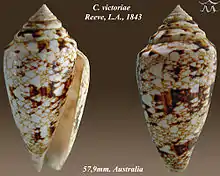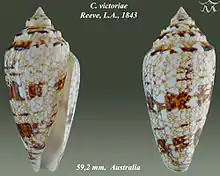Conus victoriae
Conus victoriae, common name the Queen Victoria cone, is a species of sea snail, a marine gastropod mollusk in the family Conidae, the cone snails and their allies.[1]
| Conus victoriae | |
|---|---|
 | |
| Apertural and abapertural views of shell of Conus victoriae Reeve, L.A., 1843 | |
 | |
| Scientific classification | |
| Kingdom: | Animalia |
| Phylum: | Mollusca |
| Class: | Gastropoda |
| Subclass: | Caenogastropoda |
| Order: | Neogastropoda |
| Superfamily: | Conoidea |
| Family: | Conidae |
| Genus: | Conus |
| Species: | C. victoriae |
| Binomial name | |
| Conus victoriae Reeve, 1843 | |
| Synonyms[1] | |
| |
Like all species within the genus Conus, these snails are predatory and venomous. They are capable of "stinging" humans, therefore live ones should be handled carefully or not at all.
Taxonomy
Conus nodulosus has often been treated as a geographical variant or subspecies of C. victoriae. They have a disjunct distribution, the latter occurring from Exmouth to the Western Australia / Northern Territory border, whereas nodulosus has a distribution restricted from Geraldton to Calbary and the Abrolhos. For conservation implications, the two are here listed as distinct.[1]
Description
The size of the shell varies between 35 mm and 94 mm. Conus victoriae is a mollusc-eating cone (molluscivore) possibly related to Conus textile . It differs from Conus textile in the reticulations. These are mostly smaller, arid light-colored, contrasting strongly with the bands of very dark chocolate longitudinal stripes. They are also more or less overlaid with violaceous clouds.[2]
A component of its venom, alpha conotoxin Vc1.1 (ACV1) has been shown to be a potent analgesic in pain tests in animals[3] and is a potential replacement for morphine for the treatment of neuropathic pain.[4][5]
The biology of this cone species has been extensively studied, in particular the embryonic development of its venom apparatus,[6] the expression of the venom gland proteome[7][8] and the role of the venom bulb in delivery of venom components to the radulae.[9]
Distribution
This marine species is endemic to Australia (Western Australia from Broome north to the mouth of the Victoria River, Northern Territory where it was first discovered by Reeve in 1843)
Gallery
 Conus victoriae Reeve, L.A., 1843
Conus victoriae Reeve, L.A., 1843 Conus victoriae Reeve, L.A., 1843
Conus victoriae Reeve, L.A., 1843 Conus victoriae Reeve, L.A., 1843
Conus victoriae Reeve, L.A., 1843 Conus victoriae Reeve, L.A., 1843
Conus victoriae Reeve, L.A., 1843
References
- Conus victoriae Reeve, 1843. Retrieved through: World Register of Marine Species on 27 March 2010.
- G.W. Tryon (1884) Manual of Conchology, structural and systematic, with illustrations of the species, vol. VI; Philadelphia, Academy of Natural Sciences
- Sandall, DW; Satkunanathan, N; Keays, DA; Polidano, MA; Liping, X; Pham, V; Down, JG; Khalil, Z; Livett, BG; Gayler, KR (June 2003). "A novel alpha-conotoxin identified by gene sequencing is active in suppressing the vascular response to selective stimulation of sensory nerves in vivo". Biochemistry. 42 (22): 6904–11. doi:10.1021/bi034043e.
- Livett, BG; Sandall, DW; Keays, D; Down, J; Gayler, KR; Satkunanathan, N; Khalil, Z (December 2006). "Therapeutic applications of conotoxins that target the neuronal nicotinic acetylcholine receptor". Toxicon. 48 (7): 810–29. doi:10.1016/j.toxicon.2006.07.023. PMID 16979678.
- Clark, RJ; Jensen, J; Nevin, ST; Callaghan, BP; Adams, DJ; Craik, DJ (September 2010). "The engineering of an orally active conotoxin for the treatment of neuropathic pain". Angew Chem Int Ed Engl. 49 (37): 6545–8.
- Safavi-Hemami, H; Siero, WA; Kuang, Z; Williamson, NA; Karas, JA; Page, LR; MacMillan, D; Callaghan, B; Kompella, SN; Adams, DJ; Norton, RS; Purcell, AW (June 2011). "Embryonic toxin expression in the cone snail Conus victoriae: primed to kill or divergent function?". J Biol Chem. 286 (25): 22546–57. doi:10.1074/jbc.m110.217703. PMC 3121399. PMID 21504902.
- Townsend, A.; Livett, BG; Bingham, J-P; Truong, H-T; Karas, JA; O'Donnell, P; Williamson, NA; Purcell, AW; Scanlon, D (2009). "Mass spectral identification of Vc1.1 and differential distribution of conopeptides in the venom duct of Conus victoriae. Effect of post-translational modifications and disulfide isomerisation on bioactivity". Int. J. Peptide Res and Therap. 15 (3): 195–203. doi:10.1007/s10989-009-9173-4.
- Safavi-Hemami, H; Siero, WA; Gorasia, DG; Young, ND; Macmillan, D; Williamson, NA; Purcell, AW (September 2011). "Specialisation of the venom gland proteome in predatory cone snails reveals functional diversification of the conotoxin biosynthetic pathway". J Proteome Res. 10 (9): 3904–19. doi:10.1021/pr1012976.
- Safavi-Hemami, H; Young, ND; Williamson, NA; Purcell, AW (November 2010). "Proteomic interrogation of venom delivery in marine cone snails: novel insights into the role of the venom bulb". J Proteome Res. 9 (11): 5610–9. doi:10.1021/pr100431x.
- Reeve, L.A. 1843. Descriptions of new species of shells figured in the 'Conchologia Iconica'. Proceedings of the Zoological Society of London 11: 169–197
- Reeve, L.A. 1843. Monograph of the genus Conus. pls 1–39 in Reeve, L.A. (ed.). Conchologica Iconica. London : L. Reeve & Co. Vol. 1.
- Sowerby, G.B. 1866. Thesaurus Conchyliorum, or monographs of genera of shells. London : G.B. Sowerby Vol. 3 277–331 pls 266–290.
- Wilson, B.R. & Gillett, K. 1971. Australian Shells: illustrating and describing 600 species of marine gastropods found in Australian waters. Sydney : Reed Books 168 pp.
- Wilson, B. 1994. Australian Marine Shells. Prosobranch Gastropods. Kallaroo, WA : Odyssey Publishing Vol. 2 370 pp.
- Röckel, D., Korn, W. & Kohn, A.J. 1995. Manual of the Living Conidae. Volume 1: Indo-Pacific Region. Wiesbaden : Hemmen 517 pp.
- Petit, R. E. (2009). George Brettingham Sowerby, I, II & III: their conchological publications and molluscan taxa. Zootaxa. 2189: 1–218
- Puillandre, N.; Duda, T.F.; Meyer, C.; Olivera, B.M.; Bouchet, P. (2015). "One, four or 100 genera? A new classification of the cone snails". Journal of Molluscan Studies. 81: 1–23. doi:10.1093/mollus/eyu055. PMC 4541476. PMID 26300576.
External links
- The Conus Biodiversity website
- Cone Shell and Conotoxins website
- Pain Killer Comes out of its Shell – The Age 25 July 2005
- Internet Interview with Bruce Livett
- Nervous System – Cone Snail Toxin from Untamed Science
- Cone Shells – Knights of the Sea
- "Cylinder victoriae victoriae". Gastropods.com. Retrieved 16 January 2019.
| Wikimedia Commons has media related to Conus victoriae. |